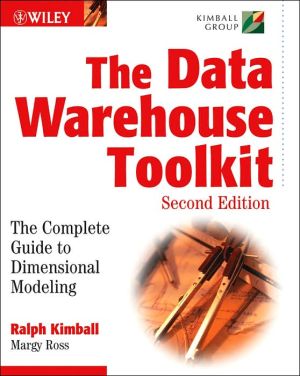The Data Warehouse Toolkit: The Complete Guide to Dimensional Modeling
The latest edition of the single most authoritative guide on dimensional modeling for data warehousing!\ Dimensional modeling has become the most widely accepted approach for data warehouse design. Here is a complete library of dimensional modeling techniques— the most comprehensive collection ever written. Greatly expanded to cover both basic and advanced techniques for optimizing data warehouse design, this second edition to Ralph Kimball's classic guide is more than sixty percent...
Search in google:
The latest edition of the single most authoritative guide on dimensional modeling for data warehousing!Dimensional modeling has become the most widely accepted approach for data warehouse design. Here is a complete library of dimensional modeling techniques— the most comprehensive collection ever written. Greatly expanded to cover both basic and advanced techniques for optimizing data warehouse design, this second edition to Ralph Kimball's classic guide is more than sixty percent updated.The authors begin with fundamental design recommendations and gradually progress step-by-step through increasingly complex scenarios. Clear-cut guidelines for designing dimensional models are illustrated using real-world data warehouse case studies drawn from a variety of business application areas and industries, including:* Retail sales and e-commerce* Inventory management* Procurement* Order management* Customer relationship management (CRM)* Human resources management* Accounting* Financial services* Telecommunications and utilities* Education* Transportation* Health care and insuranceBy the end of the book, you will have mastered the full range of powerful techniques for designing dimensional databases that are easy to understand and provide fast query response. You will also learn how to create an architected framework that integrates the distributed data warehouse using standardized dimensions and facts.Wiley Computer Publishing. Timely. Practical. Reliable.Visit our Web site at www.wiley.com/compbooks/Visit Kimball's Web site at www.kimballuniversity.com Booknews Utilizing case studies from a variety of business applications, the authors present dimensional modeling techniques for data warehousing. Emphasizing user understandability and query performance, chapters cover techniques in the areas of retail sales , inventory, procurement, order management, customer relationship management, accounting, human resource management, financial services, telecommunications and utilities, transportation, education, health care, electronic commerce, and insurance. Final chapters discuss the construction of the data warehouse framework and future trends. Annotation c. Book News, Inc., Portland, OR
AcknowledgmentsIntroductionCh. 1Dimensional Modeling Primer1Ch. 2Retail Sales29Ch. 3Inventory67Ch. 4Procurement89Ch. 5Order Management107Ch. 6Customer Relationship Management141Ch. 7Accounting173Ch. 8Human Resources Management187Ch. 9Financial Services199Ch. 10Telecommunications and Utilities217Ch. 11Transportation229Ch. 12Education243Ch. 13Health Care255Ch. 14Electronic Commerce277Ch. 15Insurance305Ch. 16Building the Data Warehouse331Ch. 17Present Imperatives and Future Outlook371Glossary389Index419
\ From Barnes & NobleTwo acclaimed data warehouse experts share an unmatched library of techniques -- both basic and advanced -- for designing fast, versatile, accessible dimensional databases. They also illustrate their methods at work in e-commerce, financial services, telecommunications, transportation, education, health care, and other industries.\ \ \ \ \ Utilizing case studies from a variety of business applications, the authors present dimensional modeling techniques for data warehousing. Emphasizing user understandability and query performance, chapters cover techniques in the areas of retail sales , inventory, procurement, order management, customer relationship management, accounting, human resource management, financial services, telecommunications and utilities, transportation, education, health care, electronic commerce, and insurance. Final chapters discuss the construction of the data warehouse framework and future trends. Annotation c. Book News, Inc., Portland, OR\ \







